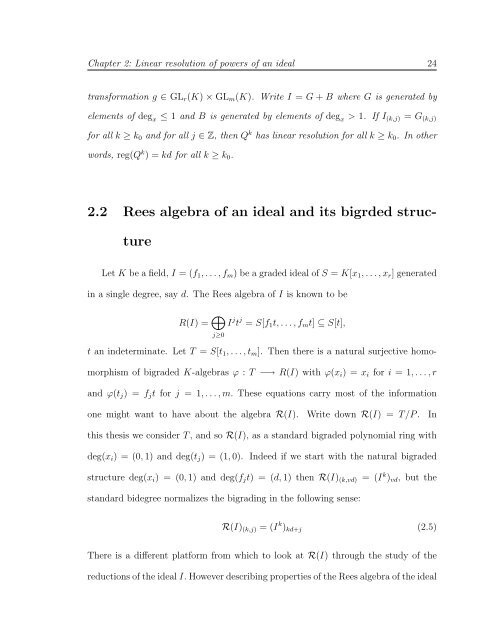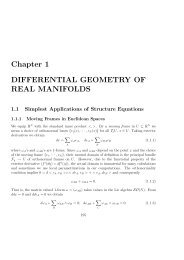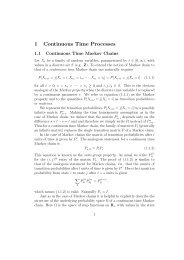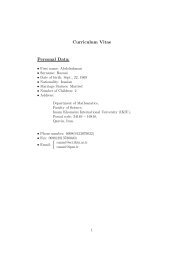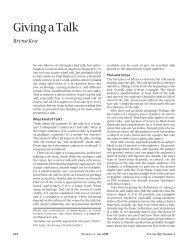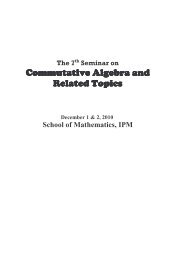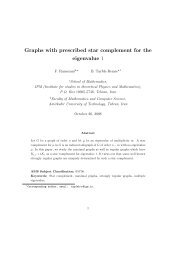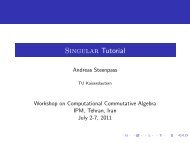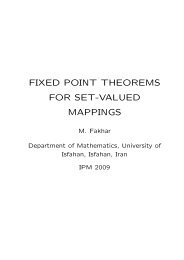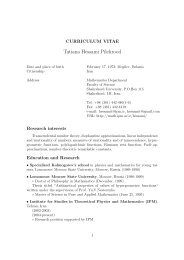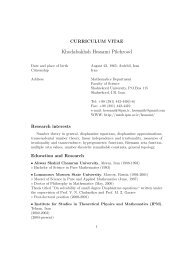Betti numbers of modules over Noetherian rings with ... - IPM
Betti numbers of modules over Noetherian rings with ... - IPM
Betti numbers of modules over Noetherian rings with ... - IPM
Create successful ePaper yourself
Turn your PDF publications into a flip-book with our unique Google optimized e-Paper software.
Chapter 2: Linear resolution <strong>of</strong> powers <strong>of</strong> an ideal 24<br />
transformation g ∈ GLr(K) × GLm(K). Write I = G + B where G is generated by<br />
elements <strong>of</strong> deg x ≤ 1 and B is generated by elements <strong>of</strong> deg x > 1. If I(k,j) = G(k,j)<br />
for all k ≥ k0 and for all j ∈ Z, then Q k has linear resolution for all k ≥ k0. In other<br />
words, reg(Q k ) = kd for all k ≥ k0.<br />
2.2 Rees algebra <strong>of</strong> an ideal and its bigrded struc-<br />
ture<br />
Let K be a field, I = (f1, . . . , fm) be a graded ideal <strong>of</strong> S = K[x1, . . . , xr] generated<br />
in a single degree, say d. The Rees algebra <strong>of</strong> I is known to be<br />
R(I) = <br />
j≥0<br />
I j t j = S[f1t, . . . , fmt] ⊆ S[t],<br />
t an indeterminate. Let T = S[t1, . . . , tm]. Then there is a natural surjective homo-<br />
morphism <strong>of</strong> bigraded K-algebras ϕ : T −→ R(I) <strong>with</strong> ϕ(xi) = xi for i = 1, . . . , r<br />
and ϕ(tj) = fjt for j = 1, . . . , m. These equations carry most <strong>of</strong> the information<br />
one might want to have about the algebra R(I). Write down R(I) = T/P . In<br />
this thesis we consider T , and so R(I), as a standard bigraded polynomial ring <strong>with</strong><br />
deg(xi) = (0, 1) and deg(tj) = (1, 0). Indeed if we start <strong>with</strong> the natural bigraded<br />
structure deg(xi) = (0, 1) and deg(fjt) = (d, 1) then R(I)(k,vd) = (I k )vd, but the<br />
standard bidegree normalizes the bigrading in the following sense:<br />
R(I)(k,j) = (I k )kd+j<br />
(2.5)<br />
There is a different platform from which to look at R(I) through the study <strong>of</strong> the<br />
reductions <strong>of</strong> the ideal I. However describing properties <strong>of</strong> the Rees algebra <strong>of</strong> the ideal


